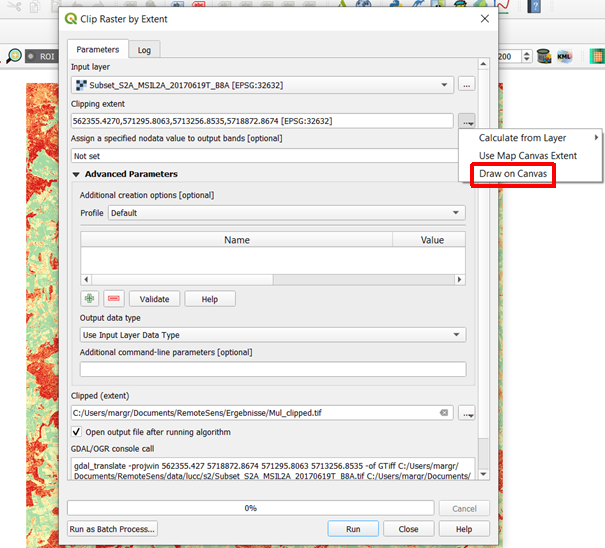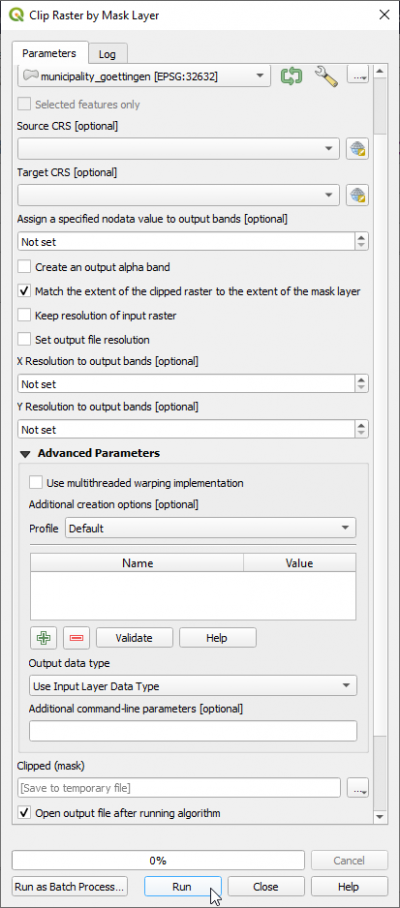Spatial subset
From AWF-Wiki
(Difference between revisions)
(→Masking by vector polygon) |
|||
| (43 intermediate revisions by one user not shown) | |||
| Line 1: | Line 1: | ||
| − | # Click the {{button|text= | + | == Interactive box selection == |
| − | + | # Click the {{button|text=Open Data Source Manager}} [[Image:QGIS_3.0_datasource.png|30px]] and {{button|text=Add raster layer}} [[Image:QGIS_2.0_addrast.png|20px]] and select a multiband raster file. | |
| − | # {{mitem|text=Raster --> Extraction ---> | + | # {{mitem|text=Raster --> Extraction ---> Clip Raster by Extent}} |
| − | # Input | + | # Input layer: Choose a loaded raster file from the drop down list or click [[File:QGIS_file_select.png]] to browse for a file. |
| − | # | + | # Define the clipping extent by clicking [[File:QGIS_file_select.png]] and select '''Draw on canvas'''. The clipping mode is now active. Hold a left click on the map canvas dragging a box of your region of interest. |
| − | + | # Clipped (extent): click [[File:QGIS_file_select.png]] to choose a new file name for the subset image. | |
| − | # Adjust the extent coordinates in the text file rounding the coordinates | + | # Adjust the extent coordinates in the text file rounding the coordinates (upper left and lower right). |
| − | [[File:Qgis_raster_clipper.png| | + | [[File:Qgis_raster_clipper.png|700px]] |
| − | + | * Click {{button|text=Run}}. | |
| + | == Masking by vector polygon == | ||
| + | * Load the vector file (e.g. administrative boundary). | ||
| + | * Select a community of your choice: right click {{mitem|text=Open Attribute Table}} | ||
| + | |||
| + | * {{mitem|text=Raster --> Extraction ---> Clip Raster by Mask Layer...}} | ||
| + | # Input layer: Choose a loaded raster file from the drop down list or click [[File:QGIS_file_select.png]] to browse to a file. | ||
| + | # Mask layer: Select the vector file (s. above). | ||
| + | # Assign a specofied nodata value: {{button|text=65535}} | ||
| + | # Switch the checkbox on: '''Match the extent of the clipped raster to the extent of the mask layer'''. All image data outside the polygon will be masked. | ||
| + | # Clipped (extent)): click {{button|text=Select}} to choose a new file name for the subset image. | ||
| + | # Click {{button|text=Run}}. | ||
| + | [[File:Qgis_raster_mask.png|400px]] | ||
[[Category: Working with Raster Data]] | [[Category: Working with Raster Data]] | ||
Latest revision as of 10:57, 31 May 2021
[edit] Interactive box selection
- Click the Open Data Source Manager
 and Add raster layer
and Add raster layer  and select a multiband raster file.
and select a multiband raster file.
- Raster --> Extraction ---> Clip Raster by Extent
- Input layer: Choose a loaded raster file from the drop down list or click
 to browse for a file.
to browse for a file.
- Define the clipping extent by clicking
 and select Draw on canvas. The clipping mode is now active. Hold a left click on the map canvas dragging a box of your region of interest.
and select Draw on canvas. The clipping mode is now active. Hold a left click on the map canvas dragging a box of your region of interest.
- Clipped (extent): click
 to choose a new file name for the subset image.
to choose a new file name for the subset image.
- Adjust the extent coordinates in the text file rounding the coordinates (upper left and lower right).
- Click Run.
[edit] Masking by vector polygon
- Load the vector file (e.g. administrative boundary).
- Select a community of your choice: right click Open Attribute Table
- Raster --> Extraction ---> Clip Raster by Mask Layer...
- Input layer: Choose a loaded raster file from the drop down list or click
 to browse to a file.
to browse to a file.
- Mask layer: Select the vector file (s. above).
- Assign a specofied nodata value: 65535
- Switch the checkbox on: Match the extent of the clipped raster to the extent of the mask layer. All image data outside the polygon will be masked.
- Clipped (extent)): click Select to choose a new file name for the subset image.
- Click Run.

